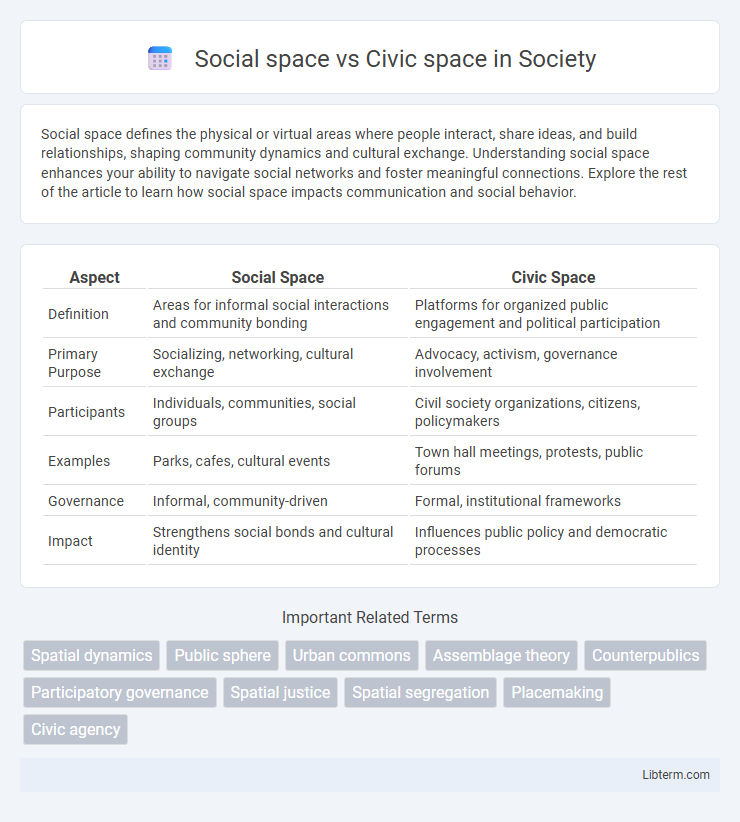Social space defines the physical or virtual areas where people interact, share ideas, and build relationships, shaping community dynamics and cultural exchange. Understanding social space enhances your ability to navigate social networks and foster meaningful connections. Explore the rest of the article to learn how social space impacts communication and social behavior.
Table of Comparison
| Aspect | Social Space | Civic Space |
|---|---|---|
| Definition | Areas for informal social interactions and community bonding | Platforms for organized public engagement and political participation |
| Primary Purpose | Socializing, networking, cultural exchange | Advocacy, activism, governance involvement |
| Participants | Individuals, communities, social groups | Civil society organizations, citizens, policymakers |
| Examples | Parks, cafes, cultural events | Town hall meetings, protests, public forums |
| Governance | Informal, community-driven | Formal, institutional frameworks |
| Impact | Strengthens social bonds and cultural identity | Influences public policy and democratic processes |
Defining Social Space and Civic Space
Social space refers to the physical or virtual arenas where individuals and groups interact, express identities, and build relationships influenced by cultural, economic, and social factors. Civic space specifically denotes environments that enable public participation in democratic processes, including freedom of assembly, expression, and association, crucial for governance and human rights advocacy. Both spaces intersect but differ as social space centers on everyday social interactions while civic space emphasizes collective civic engagement and political accountability.
Historical Evolution of Social and Civic Spaces
The historical evolution of social and civic spaces reflects shifting societal priorities, where social spaces originated primarily as informal, communal gathering areas fostering interpersonal relationships, while civic spaces developed as organized venues for public discourse and political engagement. In ancient civilizations like Greece and Rome, agora and forums served dual functions, evolving over time into distinct civic spaces emphasizing governance and democratic participation. The Industrial Revolution and urbanization accelerated this differentiation, with social spaces transforming into parks and plazas aimed at leisure, whereas civic spaces became institutionalized as squares and halls supporting civic identity and public deliberation.
Core Characteristics of Social Space
Social space is characterized by informal networks and community interactions that foster trust, cooperation, and shared cultural values, differing from civic space which emphasizes formal political engagement and institutional participation. Core characteristics of social space include relational dynamics, social capital, and the creation of safe environments for dialogue and communal support. This space supports collective identity and grassroots mobilization essential for societal cohesion and empowerment.
Key Features of Civic Space
Civic space is characterized by its emphasis on governance, participation, and transparency, enabling citizens to engage with public institutions and influence policy-making. It provides legal frameworks that protect freedoms of expression, assembly, and association, fostering an environment for advocacy and democratic dialogue. Unlike social space, which primarily facilitates informal social interactions and community building, civic space is structured to support accountability and collective decision-making processes.
Social Space vs Civic Space: Key Differences
Social space refers to informal environments where individuals interact for personal relationships, leisure, and community bonding, emphasizing social connections and cultural expression. Civic space involves formal arenas for public participation, collective decision-making, and advocacy, focusing on rights, governance, and policy influence. The key differences lie in their purposes: social space centers on social interaction and community life, while civic space prioritizes public engagement, accountability, and democratic processes.
The Role of Social Space in Community Building
Social space functions as a dynamic environment where individuals interact, share experiences, and foster relationships essential for community building. By facilitating informal gatherings and cultural expressions, social spaces enhance trust, collective identity, and mutual support among community members. These interactions lay the groundwork for increased civic engagement by empowering residents to participate actively in civic space initiatives and local governance.
Civic Space and Democratic Participation
Civic space refers to the environment that allows individuals and groups to engage in public life, express opinions, assemble peacefully, and participate in governance processes. Democratic participation thrives within a robust civic space, empowering citizens to influence policy-making, hold authorities accountable, and contribute to the protection of human rights. Restrictions on civic space, such as limitations on freedom of speech or assembly, directly undermine democratic participation and weaken the foundation of inclusive governance.
Overlapping Functions: Where Social and Civic Spaces Intersect
Social and civic spaces often overlap in functions by facilitating community engagement and fostering collective identity through public interactions and shared activities. Both spaces serve as platforms for dialogue, collaboration, and organizing social or political events, enabling citizens to participate actively in societal development. The intersection of social and civic spaces enhances social capital while promoting democratic participation and civic responsibility.
Challenges Threatening Social and Civic Spaces
Social spaces and civic spaces face overlapping challenges such as shrinking freedom of expression, restrictive government regulations, and increasing surveillance that undermine public trust and limit participation. Digital platforms, essential for social interactions, often encounter censorship and misinformation, which degrade the quality and safety of civic dialogue. Economic inequalities and spatial segregation exacerbate exclusion, reducing access to both social and civic spaces for marginalized communities.
Future Trends in Social and Civic Spaces
Future trends in social and civic spaces emphasize the integration of digital technologies such as augmented reality and blockchain to enhance community engagement and transparency. Hybrid spaces combining physical interaction with virtual connectivity will redefine participation, enabling inclusive decision-making and real-time collaboration. Data-driven urban design will optimize social infrastructure, fostering resilient communities and adaptive civic environments.
Social space Infographic

 libterm.com
libterm.com